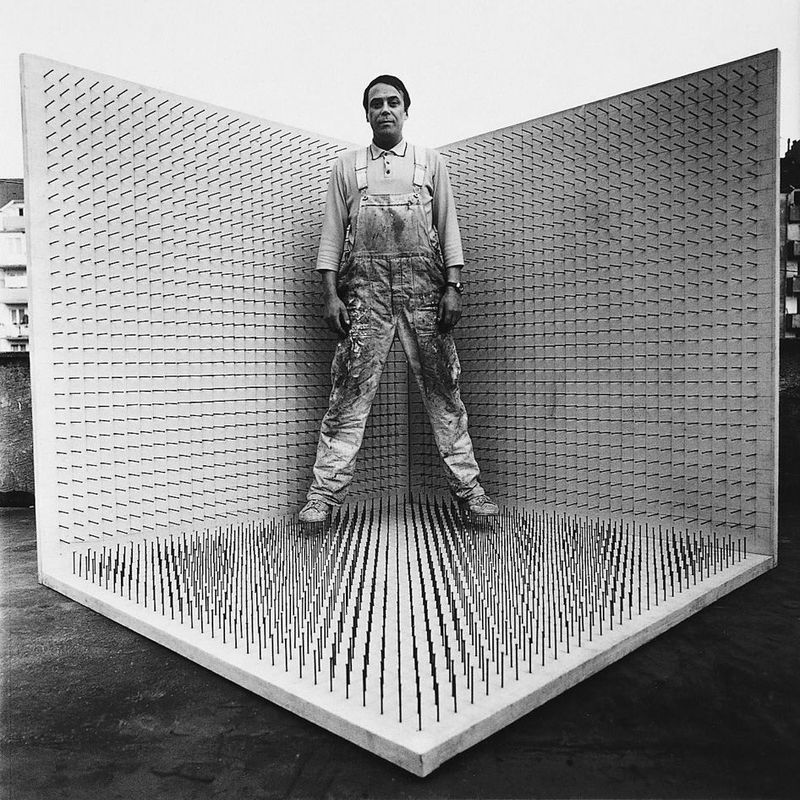Günther Uecker
“My objects are a spatial reality, a zone of light. I use mechanical means to overcome the subjective gesture, to objectify, to create a situation of freedom.”
A central figure of Düsseldorf’s postwar Group Zero, Günther Uecker has for seven decades developed his reliefs comprising dynamic arrangements of nails. Born in 1930 in Wendorf, Germany, Uecker studied at the Kunsthochschule Berlin Weissensee and Kunstakademie in Düsseldorf, where he lives and works today. In the 1950s, influenced by Eastern philosophy and Gregorian chanting, he began a ritual of hammering nails. These materials signify protection and creation to the artist, who remembers nailing planks over the windows of his home to deter Soviet troops after the Second World War. By 1957, he was hammering nails onto canvas to achieve a “sundial” optical effect, casting light and shadow in ephemeral patterns. Soon, he integrated lightboxes, rotating discs, television sets, and chairs (Stuhl, 1963) into his nail sculptures. In 1961, Uecker joined Heinz Mack and Otto Piene in the anti-expressionist movement Group Zero, which prioritized expanding beyond the traditional dimensions of the canvas into kinetic, serial, and participatory realms. After the group’s dissolution in 1966, Uecker’s work incorporated aspects of conceptual and land art, and he began designing stage sets for operas. Among his public works are From Darkness to Light at the United Nations, Geneva (1978) and a Reflection and Prayer Room for the Reichstag, Berlin (1998–99). In 2020, he embarked on his series Lichtbogen, paintings of radiant blue-and-white arcs—and in 2022, his most recent series of nail reliefs Shields.
Uecker’s work has been the subject of solo exhibitions at museums worldwide. Retrospectives of his work have been organized by the Central House of Artists, Moscow (1988) and Kunsthalle München (1993), and he participated in Documenta (1964, 1968, 1977) and the 1970 Venice Biennale. His work resides in such collections as the Art Institute of Chicago; Museum of Contemporary Art, Los Angeles; Solomon R. Guggenheim Museum and Museum of Modern Art, New York; Walker Art Center, Minneapolis; Hamburger Bahnhof, Berlin; Museum Ludwig, Cologne; Centre Pompidou, Paris; Stedelijk Museum, Amsterdam; and Tate, London. Among his many honors are the Pour le Mérite for Sciences and Arts (2000) and the Staatspreis des Landes Nordrhein-Westfalen (2015).
Exhibitions
- Günther Uecker: Arc of Light
- Lévy Gorvy Dayan, New York
- April 11 - May 5, 2024
- Günther Uecker: Shields
- LGDR, New York
- November 15 - December 23, 2022
- Günther Uecker: Shield
- LGDR, Palm Beach
- March 25 - April 14, 2022
- Günther Uecker at 40 Albemarle Street
- Lévy Gorvy, London
- October 27 - November 30, 2020
- Günther Uecker: Lichtbogen
- Lévy Gorvy, Paris
- October 22, 2020 - January 23, 2021
- Günther Uecker: Notations
- Lévy Gorvy, New York
- November 7, 2019 - January 25, 2020
- Günther Uecker: Verletzte Felder
- Dominique Lévy, London
- September 23 - October 29, 2016
Selected Artworks
- Günther Uecker
- Shield, 2022
- Paint, nails, and graphite on canvas laid down on wood
- 41⅜ × 29½ inches (105.1 × 75 cm)
- Günther Uecker
- Shield, 2022
- Paint, nails, and graphite on canvas laid down on wood
- 41⅜ × 29½ inches (105.1 × 75 cm)
- Günther Uecker
- Swabs, 2022
- Graphite and paint on paper in 42 parts
- Each: 13¾ × 9¹³⁄₁₆ inches (35 × 25 cm)
- Günther Uecker
- Lichtbogen, 2020
- Watercolor and paint on canvas
- 118⅛ × 78¾ inches (300 × 200 cm)
- Günther Uecker
- Lichtbogen, 2020
- Watercolor and paint on canvas
- 118⅛ × 78¾ inches (300 × 200 cm)
- Günther Uecker
- Untitled, 1967
- Nails, tempera, and varnish on canvas laid on board
- 29½ × 39⅜ × 3⅛ inches (74.9 × 100 × 7.9 cm)
- Günther Uecker
- Schichtung, 1965
- Nails on canvas on wood
- 15¾ × 15¾ inches (40 × 40 cm)
Selected publications
Selected Press
- NDRJuly 25, 2021
- Architectural DigestJanuary 22, 2021
- Architectural DigestJanuary 18, 2021
- Le Journal des ArtsJanuary 18, 2021
- Art ObservedJanuary 4, 2021
- AluringJanuary 1, 2021
- Il Sole 24 OreDecember 30, 2020
- Le FigaroDecember 9, 2020
- Architectural DigestDecember 4, 2020
- Tasting KitchenNovember 1, 2020
- GalleriesNowOctober 27, 2020
- ConversationOctober 27, 2020
- WhitewallOctober 23, 2020
- Les EchosOctober 23, 2020
- GalleriesNowOctober 22, 2020
- La Libre BelgiqueOctober 21, 2020
- GalleriesNowOctober 20, 2020
- Le Journal des ArtsOctober 19, 2020
- L'EchoOctober 16, 2020
- Le MondeOctober 9, 2020
- MonopolSeptember 30, 2020
- Financial TimesMay 16, 2020
- RTLFebruary 20, 2020
- Schwerin LokalFebruary 18, 2020
- MOMANovember 15, 2019
- GalleriesNowNovember 15, 2019
- FriezeNovember 15, 2019
- Art RabbitNovember 11, 2019
- Berlin Art LinkApril 27, 2017
- New York TimesFebruary 9, 2017
- TelegraphSeptember 27, 2016
- Art NewspaperSeptember 12, 2016
- Art Review AsiaJune 23, 2015
- T MagazineJune 16, 2015
- Apollo MagazineApril 10, 2015
- Arts DeskFebruary 14, 2015
- Schirn MagFebruary 13, 2015
- TimeOut LondonFebruary 10, 2015
- Architectural DigestJanuary 31, 2015
- AestheticaJanuary 9, 2015
- New York TimesApril 14, 2011
